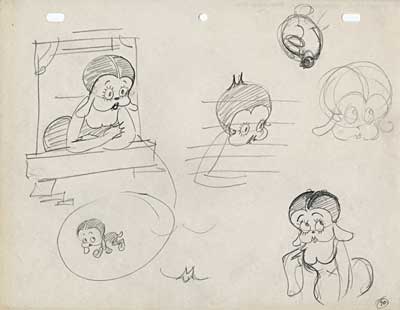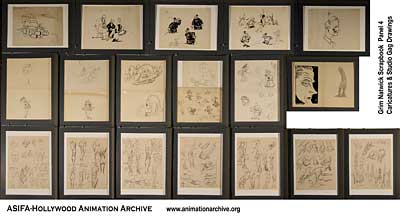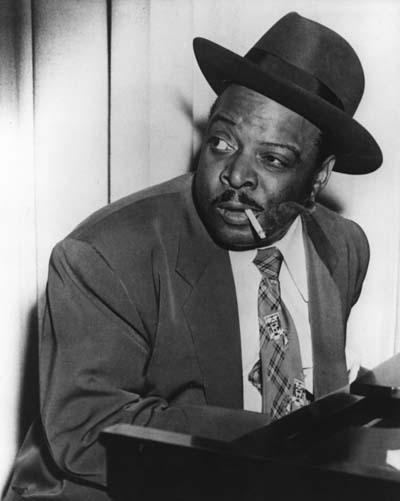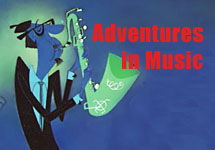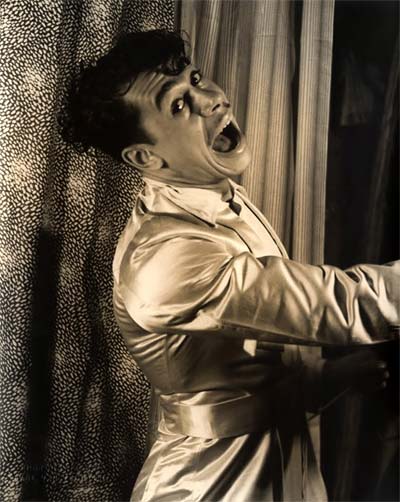PART ONE: GRIM NATWICK’S EARLY YEARS
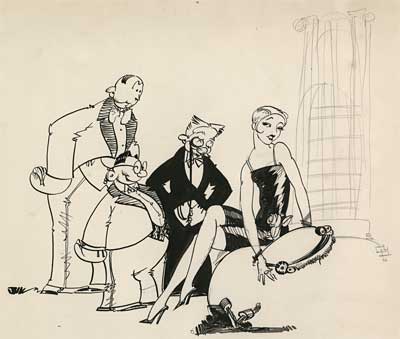
Grim Natwick’s career in animation began in 1917 at International Film Service Productions, managed by Gregory LaCava. The studio was owned by William Randolph Hearst, who wanted to exploit his comic strip characters in the new medium of the animated cartoon. LaCava had been lured away from Raoul Barre’s studio where he had been working as an animator. His organizational skills were put to good use setting the studio on the right track, but he was having trouble finding experienced animators. He did however, know of a great draftsman who was working as a sheet music illustrator- a classmate from art school…
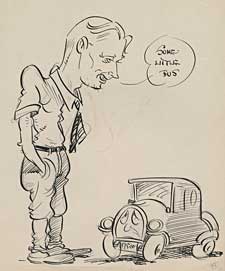
![]() LaCava enlisted Grim to help out for "for two weeks or so" until he could locate experienced animators. Grim’s first task was to animate a racehorse in a Happy Hooligan cartoon. He spent more than a week on the sequence experimenting and struggling, and at the end of the two weeks, he was ready to quit. But LaCava told him that Hearst would pay him the unheard of amount of $100 a week if he would stay on. Money talked, and ultimately, Grim took to animation like a duck to water. The two weeks ended up stretching into over seven decades.
LaCava enlisted Grim to help out for "for two weeks or so" until he could locate experienced animators. Grim’s first task was to animate a racehorse in a Happy Hooligan cartoon. He spent more than a week on the sequence experimenting and struggling, and at the end of the two weeks, he was ready to quit. But LaCava told him that Hearst would pay him the unheard of amount of $100 a week if he would stay on. Money talked, and ultimately, Grim took to animation like a duck to water. The two weeks ended up stretching into over seven decades.
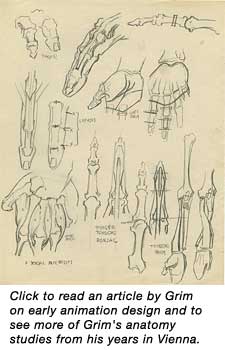
![]() Around 1920, Grim took a few years off to study art in Vienna- drawing from life, landscape painting, portraiture- a full classical art education. He returned to New York a much stronger artist than he had left. International Film Service no longer existed, but Bill Nolan had organized a studio to produce Krazy Kat cartoons. The series bore little resemblence to George Herriman’s classic comic strip. The animation was done using the "slash system" and animators were expected to not only assist their own scenes, but to ink them as well. The artists at the Krazy Kat Studio at this time included some of the best in New York, two of whom- Walter Lantz and Jimmie (Shamus) Culhane- would work with Grim again much later in his career.
Around 1920, Grim took a few years off to study art in Vienna- drawing from life, landscape painting, portraiture- a full classical art education. He returned to New York a much stronger artist than he had left. International Film Service no longer existed, but Bill Nolan had organized a studio to produce Krazy Kat cartoons. The series bore little resemblence to George Herriman’s classic comic strip. The animation was done using the "slash system" and animators were expected to not only assist their own scenes, but to ink them as well. The artists at the Krazy Kat Studio at this time included some of the best in New York, two of whom- Walter Lantz and Jimmie (Shamus) Culhane- would work with Grim again much later in his career.
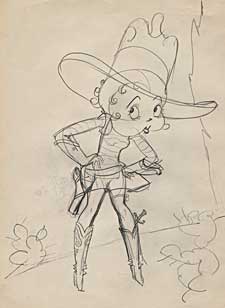
![]() In 1929, Grim joined the Fleischer Studios. Fleischer had just made the transition from silent films to sound, and was abandoning the high contrast inked look of the Out of the Inkwell cartoons for a more rounded style with a full range of gray tones. Disney had just raided the studio for talent, taking several key animators, including Dick Huemer, back to California with him. A few months later Ted Sears headed West. Grim was left with a group of inexperienced, but enthusiastic and talented young artists. He quickly whipped the crew into shape and provided the Fleischers with some of the most imaginitive animation ever produced at the studio. We’ve featured two cartoons from this period here in the past… Swing, You Sinners and Mariutch, both from 1930.
In 1929, Grim joined the Fleischer Studios. Fleischer had just made the transition from silent films to sound, and was abandoning the high contrast inked look of the Out of the Inkwell cartoons for a more rounded style with a full range of gray tones. Disney had just raided the studio for talent, taking several key animators, including Dick Huemer, back to California with him. A few months later Ted Sears headed West. Grim was left with a group of inexperienced, but enthusiastic and talented young artists. He quickly whipped the crew into shape and provided the Fleischers with some of the most imaginitive animation ever produced at the studio. We’ve featured two cartoons from this period here in the past… Swing, You Sinners and Mariutch, both from 1930.
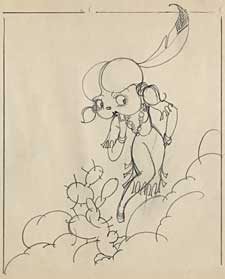
![]() One day, Dave Fleischer handed Grim a photograph of singer, Helen Kane and asked him to design a caricature. Fleischer had found a sound-alike, and planned to use her in the upcoming Talkartoon, "Dizzy Dishes". Grim exaggerated Kane’s wide eyes and rosebud mouth, creating a slightly coarse, but strikingly original design. A few weeks later, Dave asked Grim to design a girlfriend for Bimbo to star as the "fair young maiden" in a cartoon adaptation of the popular song, "Barnacle Bill the Sailor". Grim streamlined and refined his caricature of Kane for the part. But Dave Fleischer objected, insisting that since Bimbo was a dog, his girlfriend should also be a dog. Grim quickly sketched Betty Boop’s head on a four legged canine body. He held up the drawing next to the pretty girl design, and asked, "Which would you rather have as your girlfriend? A girl? Or a dog?" Dave laughed and agreed that the pretty girl was the right choice.
One day, Dave Fleischer handed Grim a photograph of singer, Helen Kane and asked him to design a caricature. Fleischer had found a sound-alike, and planned to use her in the upcoming Talkartoon, "Dizzy Dishes". Grim exaggerated Kane’s wide eyes and rosebud mouth, creating a slightly coarse, but strikingly original design. A few weeks later, Dave asked Grim to design a girlfriend for Bimbo to star as the "fair young maiden" in a cartoon adaptation of the popular song, "Barnacle Bill the Sailor". Grim streamlined and refined his caricature of Kane for the part. But Dave Fleischer objected, insisting that since Bimbo was a dog, his girlfriend should also be a dog. Grim quickly sketched Betty Boop’s head on a four legged canine body. He held up the drawing next to the pretty girl design, and asked, "Which would you rather have as your girlfriend? A girl? Or a dog?" Dave laughed and agreed that the pretty girl was the right choice.
Top Row: Animation From Hearst & The Krazy Kat Studio (left to right) Drawing from "Judge Rummy" cartoon* (ca. 1918) / Concept sketch for unproduced series based on Cliff Sterrett’s "Polly & her Pals"* (ca. 1926) / ibid* / ibid* / Self portrait of Grim Natwick* (ca. 1926)
Middle Row: Animation From Fleischer (left to right) Animation drawings from "Mariutch"* (1930) / Animation drawing from unknown film* – Animation drawing from "Mariutch"* / Animation drawings from "Swing, You Sinners"* (1930) bottom dwg- collection of Kent Butterworth / Character designs for Bimbo* (ca. 1930) / Character designs for Bimbo in "Barnacle Bill The Sailor"* (1930) / Caricature of Grim Natwick by Rudy Zamora – Self portrait of Grim Natwick* (ca. 1930)
Bottom Row: Anatomy Studies After Bridgeman* (ca. 1920)
* denotes a drawing by Grim Natwick
Next Chapter: GRIM NATWICK, GOLDEN AGE ANIMATOR (Iwerks, Disney, Lantz)
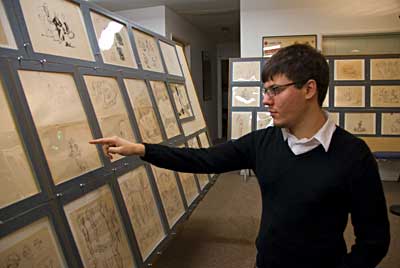
Assistant Archivist, Joseph Baptista views the exhibit.
GRIM NATWICK’S SCRAPBOOK
This travelling exhibit has appeared at the ASIFA-Hollywood Animation Archive in Burbank, CA and at the South Wood Historical Society Museum in Wisconsin Rapids, WI, birthplace of Grim Natwick.
Stephen Worth
Director
Animation Resources
This posting is part of an online exhibit entitled Grim Natwick’s Scrapbook.














